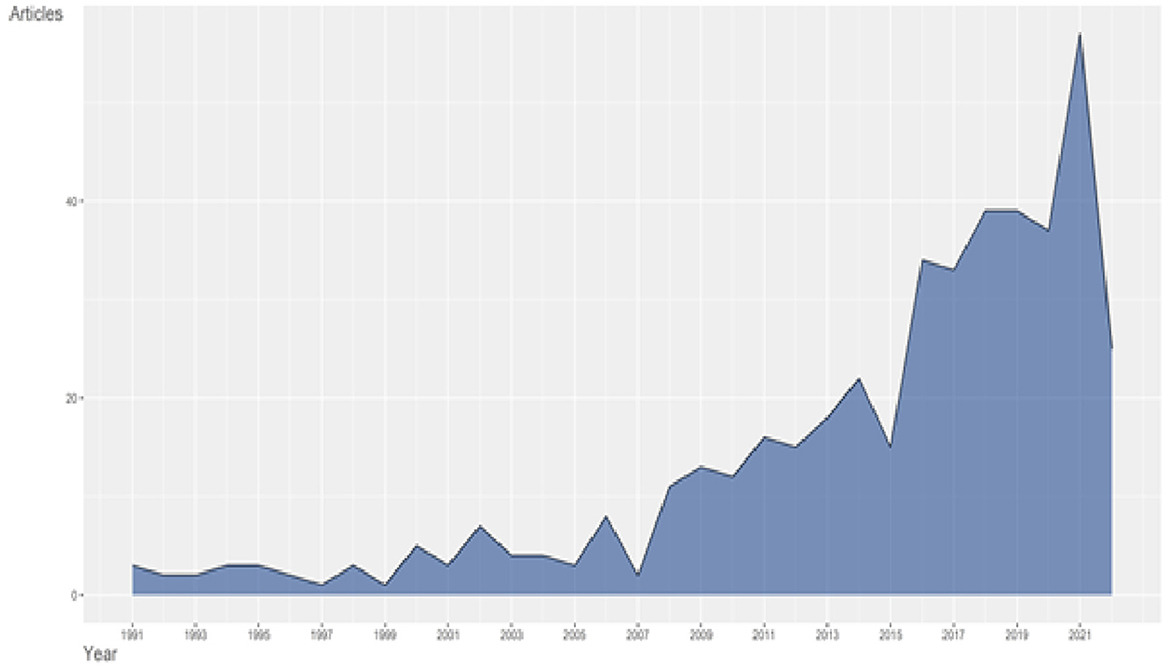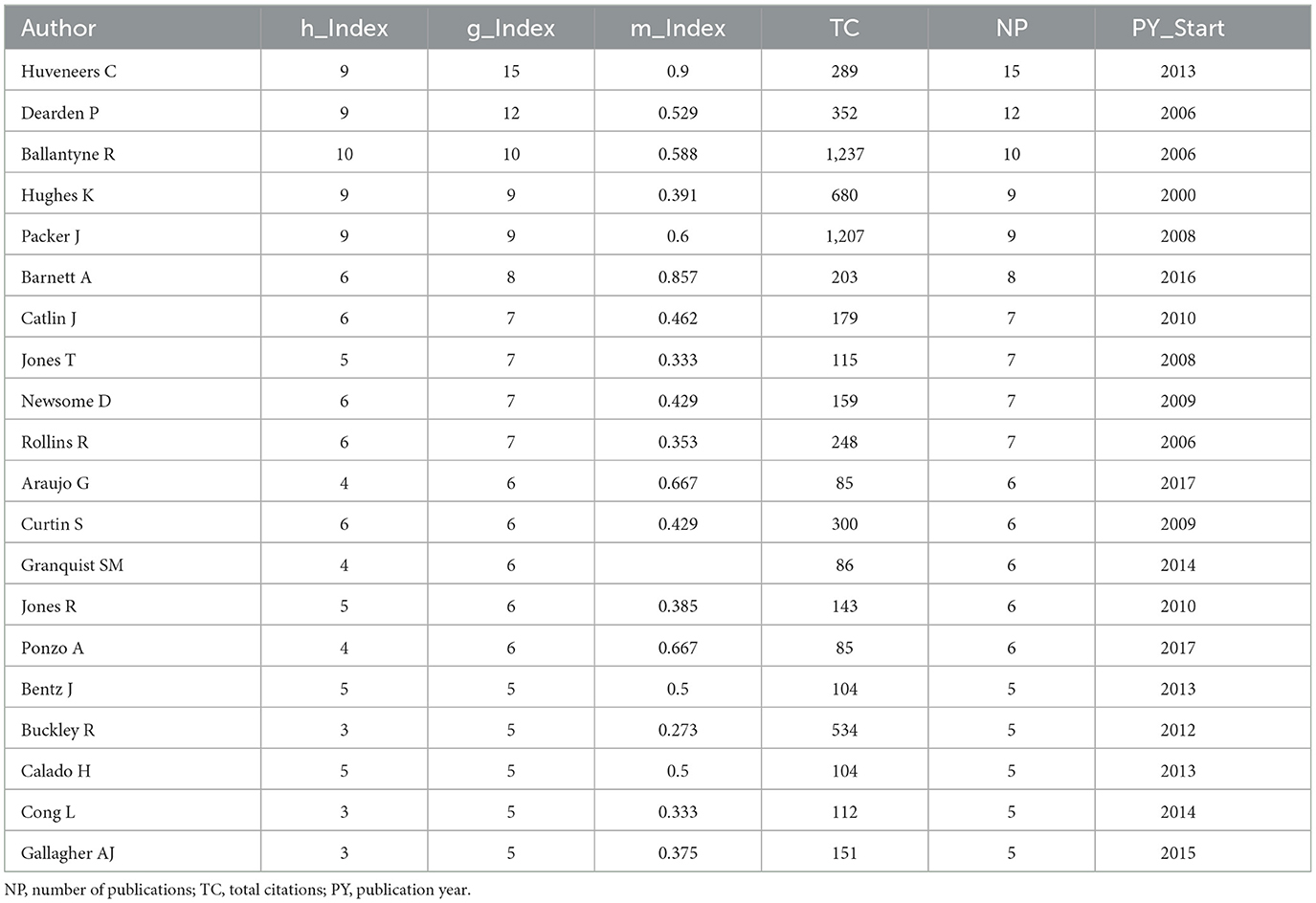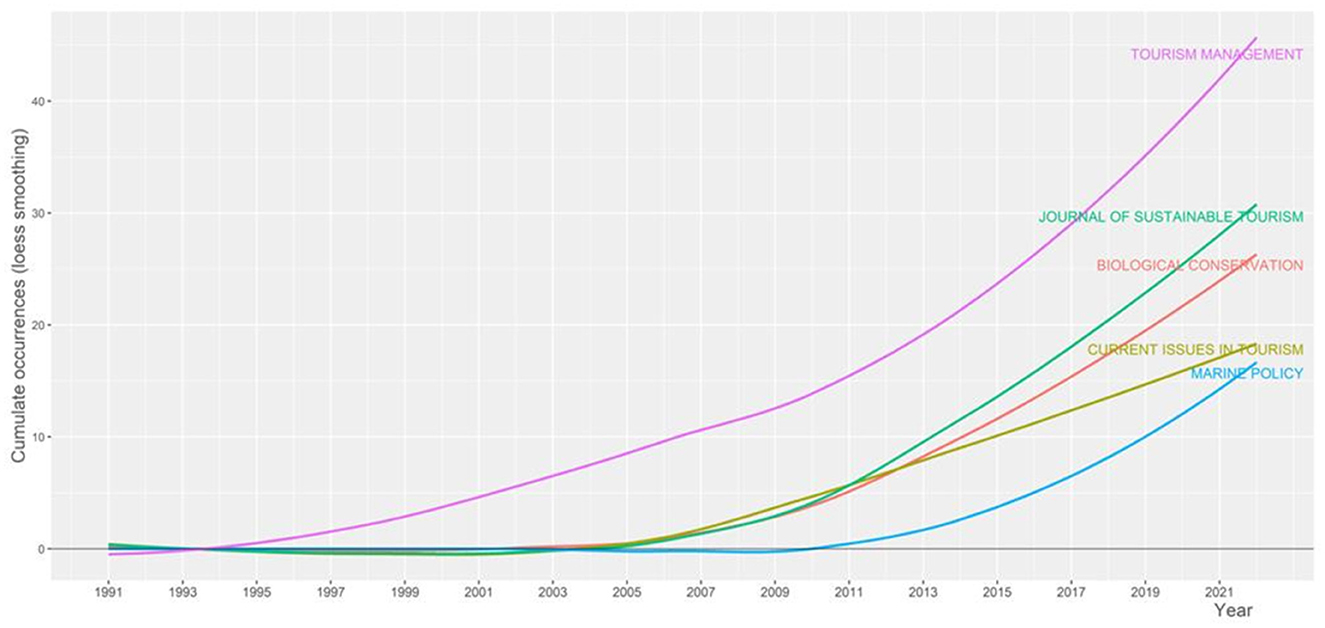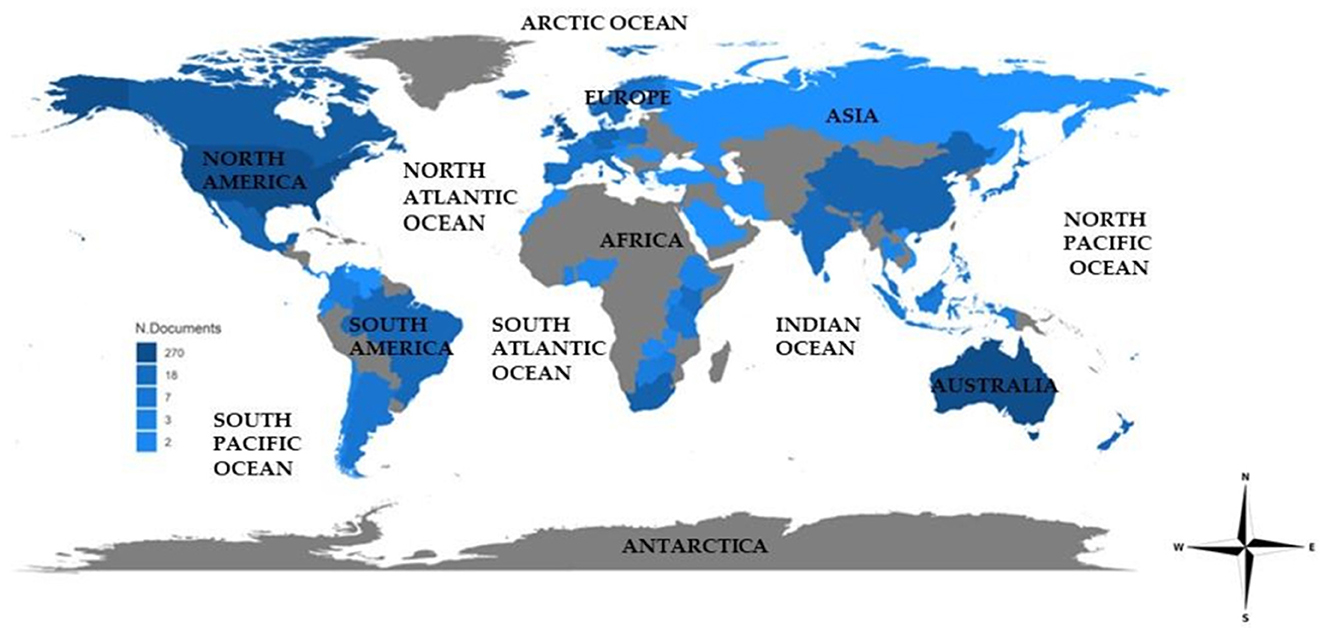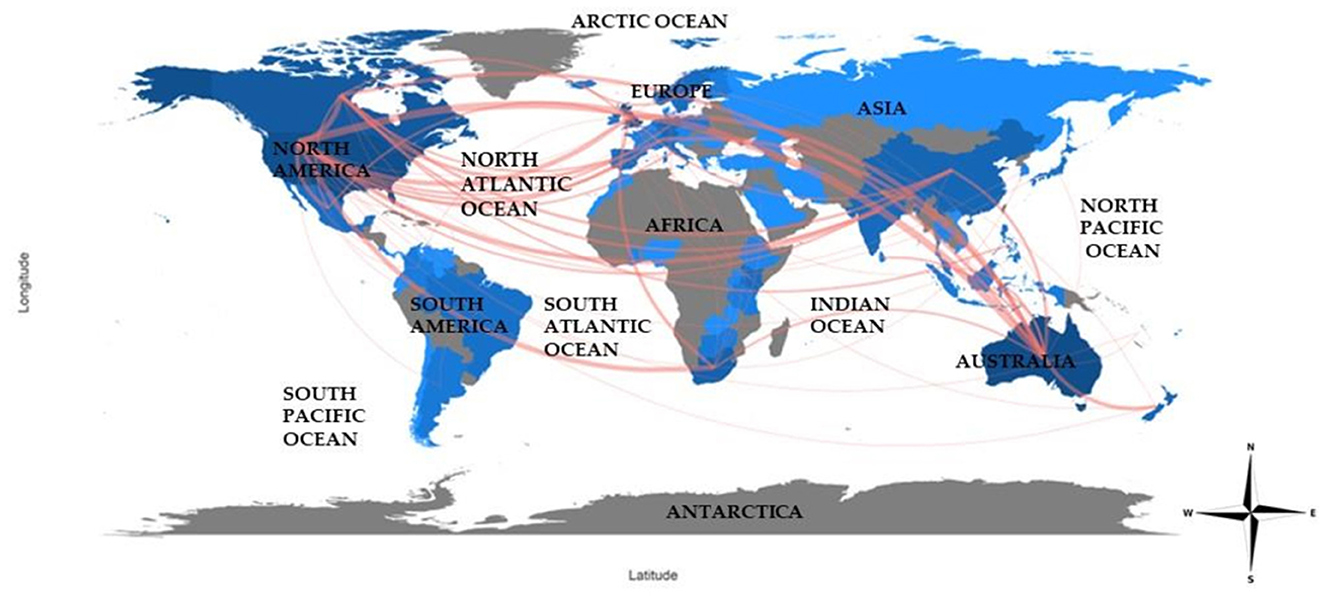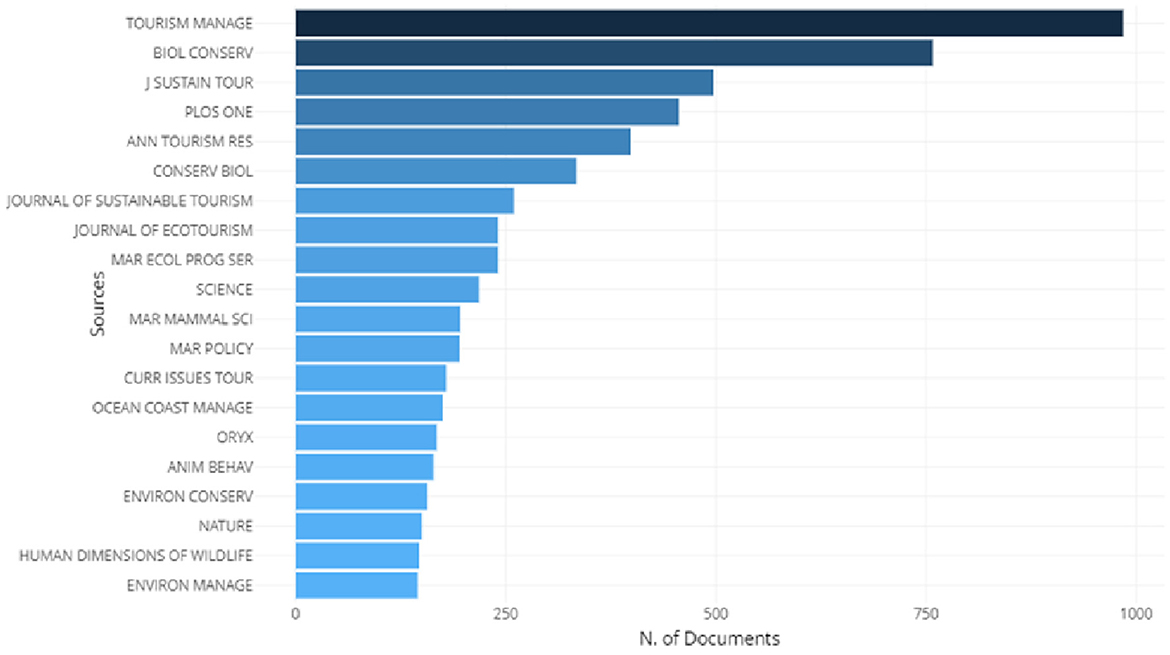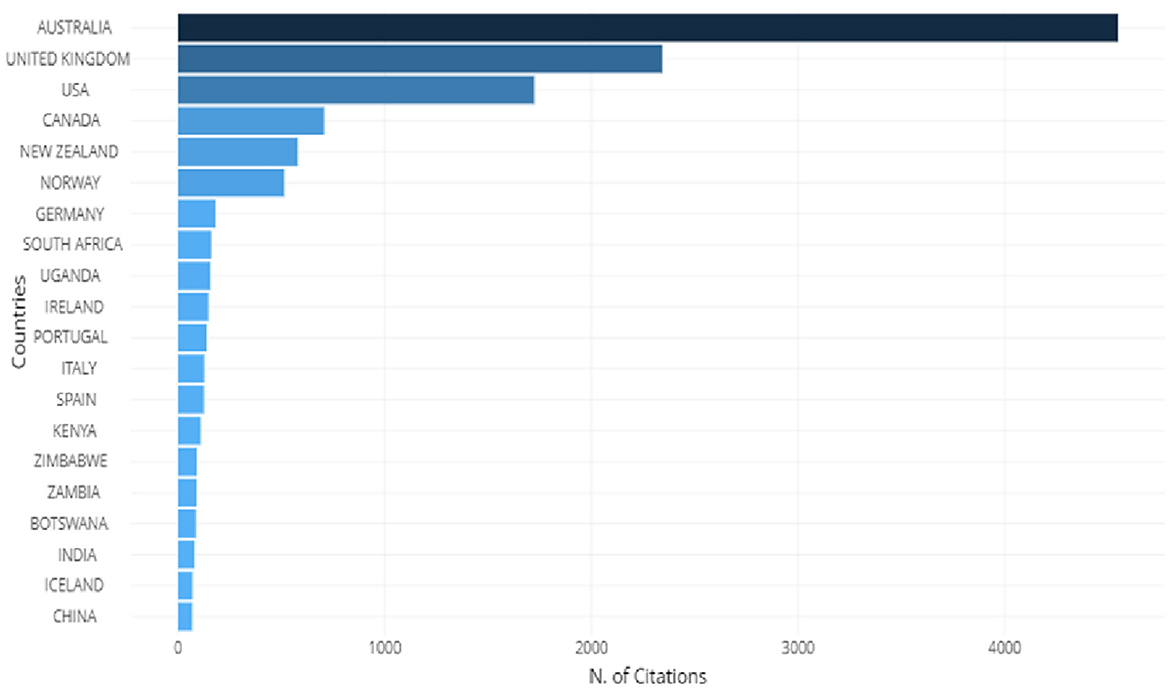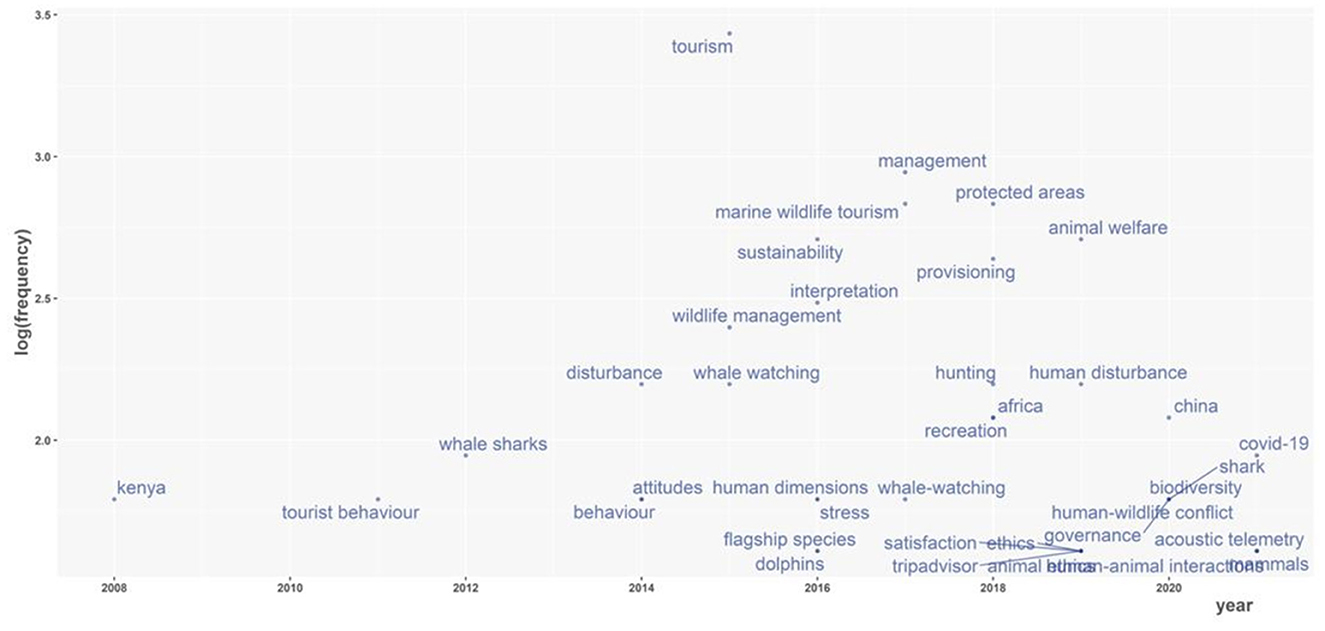- 1Centre for Hospitality and Tourism, Baba Ghulam Shah Badshah University, Rajouri, Jammu and Kashmir, India
- 2Department of Botany, Baba Ghulam Shah Badshah University, Rajouri, Jammu and Kashmir, India
- 3Centre for Biodiversity Studies, Baba Ghulam Shah Badshah University, Rajouri, Jammu and Kashmir, India
- 4Department of Wood Technology Management, Faculty of Civil Technology, Technical and Vocational Training Institute (TVTI), Addis Ababa, Ethiopia
In the present study, a bibliometric analysis of 453 publications published between 1991 and 2022 was carried out in order to evaluate and analyze the existing academic literature, as well as to identify current research trends and hotspots on this topic. Three different sorts of bibliometric indicators: quantitative, qualitative, and structural, were analyzed. The results revealed a steady increase in publications on wildlife tourism since 1991, with the journal Tourism Management being the most prolific source of research articles. A total of 70 countries and territories have contributed to these research publications, with Australia having the highest number of research publications. Among the most cited authors, sources and countries, Ballantyne R, Tourism Management, and Australia top the list, respectively. It was observed that a total of 232 research collaborations have been made across different countries in wildlife tourism research, with the highest number of collaborations between Australia and the USA. A keyword frequency analysis revealed that terms such as conservation, wildlife tourism, management, ecotourism, and wildlife behavior were the most frequently used. The present study provides insights into the current state of research in SWT and highlights key contributors, collaborations, and research themes in the field. The findings can serve as a foundation for future research in wildlife tourism by identifying core research areas, potential collaborators, and impactful journals. The study can further contribute to the growing body of knowledge in the field and guide researchers in selecting suitable journals for publishing their research works.
1 Introduction
Tourism is among the most explored subjects in contemporary economics (Lee and Chang, 2008; Bashir et al., 2015; Paramati et al., 2017) because it significantly affects the economy both directly and indirectly. Further, it is essential to the social, monetary, and infrastructure growth of the host economies, thereby contributing to the Gross Domestic Product (GDP). Ecotourism is its responsible form that contributes to the tourism sector globally by having a minimum impact on socio-cultural factors and natural resources (Walsh and George, 2019). Additionally, it promotes domestic resource utilization, and employment generation. Wildlife tourism, a subcategory of ecotourism includes non-consumptive adventures like photographing and observing animals in the wild (Rodger et al., 2007; Newsome et al., 2012; WTTC, 2019; Auster et al., 2020) and consumptive activities such as the selective animal usage, like in sport hunting and fishing (Lovelock, 2008). The emphasis here is on the “untamed” nature of creatures deemed as wildlife. In the United States, “wildlife” has traditionally meant all game animals, since hunting is seen as a way to get close to the wild (Good, 1997). Over the past 20 years, the world's wildlife tourism has grown, and scientists have become more interested in it (Sedarati et al., 2019). This growth in wildlife tourism is happening at a time when the world is worried about unpredictable climate change, political tensions, the population explosion, the loss of wilderness, and the decline of animal species. The literature indicates that there have been debates and worries regarding the adverse effects of tourism on animals, communities, and habitats (Gössling, 2002; Holden, 2008; Gladstone et al., 2013), particularly in delicate environments (Buckley, 2000; Higginbottom et al., 2003; Gladstone et al., 2013). Research has shown that wildlife tourism can have negative environmental impacts if not managed sustainably (Higginbottom et al., 2003; Holden, 2008). However, it can also bring benefits to local communities by helping them understand the value of wildlife tourism, leading to improved livelihoods and sustainable natural resource management (Kals et al., 1999; Milton, 2003). This can also foster a sense of care and responsibility toward wildlife, depending on the degree to which the host community value conservation and sustainable growth. The success of wildlife tourism largely depends on collaborative efforts between host communities and the creation of designated destinations (Liu and Li, 2020; Bilynets and Cvelbar, 2022). Rapid environmental changes (Ariya et al., 2020), economic and political volatility, natural catastrophes (Saha and Yap, 2015), and community support for biodiversity conservation and tourism all impact the sustainability of wildlife tourism.
The increasing volume of scientific publications in recent years, which are archived in bibliographic databases, has resulted in the adoption of “bibliometrics” as a valuable tool for quantitatively measuring scientific activity through the statistical analysis of literature (Sánchez et al., 2017). A bibliometric study of documents published in the Web of Science (WoS) related to wildlife tourism provide valuable insight into the evolution of research in this field. Many bibliometric studies have been previously carried out in related fields, including wine tourism, tourism sustainability, tourism recreation and sports tourism (Sánchez et al., 2017; Niñerola et al., 2019; Vishwakarma and Mukherjee, 2019; Jiménez-García et al., 2020; Bastidas-Manzano et al., 2021). By analyzing publication trends, citation patterns, and collaboration networks, it is possible to identify the most influential authors, institutions, and countries, as well as the most important research topics and themes (Sánchez et al., 2017). Understanding these trends and advances can help inform policy decisions and management practices related to wildlife tourism. For example, by identifying gaps in the research or areas where further investigation is needed, policymakers can allocate resources and prioritize research efforts accordingly. Additionally, understanding the most effective strategies for sustainable management of wildlife tourism can help promote responsible tourism practices that minimize negative impacts on wildlife and their habitats.
Therefore, in the present study a bibliometric analysis of documents published in the WoS database between 1991 and 2022 was carried out, with a focus on wildlife tourism. By employing bibliometric analysis, this study seeks to identify and analyze trends and advancements in scientific research, policy-related literature, and sustainable management practices in the field of wildlife tourism.
2 Materials and methods
Bibliometrics involves mathematical and statistical methods for analyzing and measuring the quantity and quality of books, articles, and other publications (Durieux and Gevenois, 2010). This type of analysis examines existing literature to summarize and reveal patterns in written communication and the evolution of a discipline, utilizing large data sets (Pritchard, 1969; Small, 1999). Moreover, this approach elucidates the intellectual framework of the knowledge domain (Arora and Chakraborty, 2021), highlighting its current status, emerging trends, and potential future research directions. By employing bibliometrics, we aim to gain a deeper understanding of the prevailing paradigms and research concentrations based on similarity (Rejeb et al., 2022). The use of bibliometrics offers novel insights supported by the objective rigor of the methodology (Casillas and Acedo, 2007).
2.1 Data source
Data for the present study was obtained from the WoS (www.webofscience.com, accessed on 01 January 2023), which is known for providing comprehensive coverage of scientific literature. The database comprises articles published in high-quality journals, and is particularly appropriate for bibliometric analysis (Korom, 2019). The WoS is a powerful research engine that provides libraries with secure access to publication and citation data for discovery and evaluation. It is particularly beneficial for specialized research topics, and enables more accurate co-citation analysis due to the availability of cited references (Zupic and Cater, 2015). Many bibliometric studies have utilized the WoS database (Jiménez-García et al., 2020; Bastidas-Manzano et al., 2021; Goyal and Kumar, 2021; Palácios et al., 2021; Ülker et al., 2023), to identify trends in research topics, track the impact of specific articles or authors, and map out the intellectual structure of a particular field.
2.2 Data collection and analysis
A comprehensive search of published documents from 1991–2022 related to wildlife tourism was conducted in January 2023, employing the “All databases” search option in Clarivate Analytics of WoS. Literature search was conducted using a string of keywords, including “wildlife tourism,” “adventure tourism,” “ecotourism,” and “safari.” The meta-data of publications related to wildlife tourism was obtained. A total of 1,432 documents generated on initial search and these papers were screened for their suitability for the study. Only such studies were included which primarily focus on wildlife tourism and irrelevant studies were excluded after screening of titles and abstracts. A total of 453 documents including research articles, review articles, book chapters, conference proceedings, and editorials etc. formed the final dataset and were downloaded for the bibliometric analysis.
Data were analyzed using the “bibliometrix” tool in R software. In this study, all of the bibliometric indicators such as quantitative, qualitative, and structural indicatorswere measured. Quantitativeindicators measure the productivity of a particular author or source; qualitative indicators measure the quality of a source, author, or a research group; and structural indicators measure connections between publications, authors, or research fields. In the present study, the quality of the research was evaluated using a comprehensive approach. Citation analysis served as the primary method of assessment. Additionally, various bibliometric indices were considered to provide a more nuanced evaluation. These included the h-index, which measures both the productivity and citation impact of a researcher's publications; the g-index, which gives more weight to highly-cited articles; and the m-index, which adjusts the h-index by the number of years a researcher has been active.
3 Results and discussion
3.1 Publications and production
According to the WoS, total scholarly articles on wildlife tourism published globally totaled 453 between 1991 and 2022 in different journals, including 386 articles, 10 early access articles, eight proceeding papers, five book reviews, 10 editorial materials, one correction, four letters, one meeting abstract, two news items, and 26 review papers. These publications were retrieved from a total of 153 sources, including journals, books, etc. A total of 20,480 references have been used in these publications, showing the breadth of the literature and research that has been reviewed and cited in the field. With the advent of time, the number of publications on wildlife tourism has been progressively increasing since 1991, from only three publications in 1991 to 57 publications in 2021 (Figure 1). The steady rise in annual publications suggests that research on wildlife tourism is growing significantly, which is a positive development that can lead to the advancement of knowledge and understanding in the field. Increase in the publication output in the last decade could be accredited to various factors, like the availability of online journals and the ease of access to electronic databases such as WoS. In the 1990s, many papers may have been published in print journals that may not have been included in WOS or other electronic databases, leading to the potential underrepresentation of publications from that time period. Additionally, the ease of accessing and disseminating research online has likely facilitated greater collaboration among researchers, leading to more publications in the field of wildlife tourism. The publication output is an imperative indicator for analyzing the research progression in a particular subject (Ridwan et al., 2023). However, the quantity of publications reflects an output of an author or a research group; it does not address the quality of the papers. A more selective approach to overcoming some of these restrictions is to count the number of articles in the top-quality journals with a high impact factor (Durieux and Gevenois, 2010). Moreover, it is important to acknowledge that the search for the present study was limited to English-language publications, which could potentially lead to the over sighting of significant documents in other languages.
3.2 Most productive authors, sources, countries, and institutions
The most prolific authors, sources, nations, and institutions are the key markers in bibliometric studies that identify the most influential contributors to a particular field (Sharma et al., 2021). This Information aid scholars and practitioners in relevant scientific disciplines who seek collaboration and higher education (Wani et al., 2023). With regard to authors, 1,290 of them have published their works in various periodicals. A total of 53 of them contributed documents with a single author, while 1,237 authors produced documents with multiple authors. The most productive authors are “Huveneers, C” (15 publications), “Dearden, P” (12 publications), and “Ballantyne R” (10 publications; Table 1).
Journals are considered vital tools for disseminating research; hence, the worth and reputation of a journal play an essential role in spreading knowledge to the appropriate portion of society (Shah et al., 2021). In the present study, it was revealed that the journal Tourism Management, with 43 publications is the most relevant and productive source, followed by the Journal of Sustainable Tourism with 32 publications, Biological Conservation with 24 publications, and Current Issues in Tourism with 21 publications (Figure 2). Figure 3 depicts the source dynamics, and demonstrates that the journal Tourism Management has always been the most authoritative source of wildlife tourism research. The journal “Tourism Management” publishes a fairly consistent quantity of articles on sustainability, with a significant influence based on citations. The Journal of Sustainable Tourism is solely committed to publish articles on sustainable tourism research (Lu and Nepal, 2009). Niñerola et al. (2019) has also emphasized its significance in this field.
A total of 70 countries and territories have participated to research output in the field of wildlife tourism, indicating that its global significance. Figure 4 depicts the geographic location of wildlife tourism publications in which a darker color indicates a higher research output. In the present study, Australia was found to the most productive country with the highest number of research publications (270), followed by the USA (237), UK (116), Canada (72) South Africa (52) and China (39). A similar study by Hasana et al. (2022) also observed the same countries among the list of most productive ones; however, the greatest number of publications came from the USA followed by the UK, Australia, South Africa, Canada, and China. The study carried out by Hasana et al. (2022) primarily focus on the ecotourism with special emphasis in protected areas only.
In terms of the most relevant affiliations, James Cook University of Australia turned out to be most productive in terms of the number of publications on wildlife tourism, with 30 research publications, followed by Murdoch University (24 publications), Flinders University of Australia, the University of Queensland, and the University of Western Australia (20 publications each; Supplementary Figure S1). The affiliations of the authors play an important role in research productivity, as different institutions and research organizations may have varying levels of expertise and focus on a particular field. These institutions have been actively engaged in research related to wildlife tourism, as evidenced by their high number of publications in this field.
3.3 Research collaborations
Research collaboration entails the knowledge exchange and transfer between researchers and research institutes. The trend and nature of research collaborations in the study area is identified by analyzing the pattern of co-authorships from different institutes, regions and countries (Reyes-Gonzalez et al., 2016). In the present study, it was observed that a total of 232 research collaborations have been made from different countries in wildlife tourism research. The highest number of collaborations was found between Australia and USA, accounted for 20 research publications, followed by the USA and Canada (11 publications), followed by the USA and the UK (9 publications), the USA and South Africa (nine publications), and the USA and China (8 publications). It is worth noting that the countries with the most publications on the subject of wildlife tourism also have a greater rate of cooperation, indicating that they have shared knowledge and assisted each other in generating scientifically useful outcomes. Figure 5 depicts global graphical outlook of research collaborations. The pink lines connect the collaborating countries and the thickness of the lines indicates the frequency of collaborative research publications.
3.4 Most cited authors, sources, countries and publications
Citation analysis is commonly utilized to assess the influence of authors, journals, or publications, as it enables the rapid identification of significant works in a particular field (Niñerola et al., 2019). In this approach, the number of citations received by an article determines its influence. Although there are various methods (e.g., network metrics) for measuring the worth of publications in a research field, the citation is the most clear-cut indicator of their impact. As a result, by using citations, one can investigate the most influential publications in a subject field to gain a better understanding of their intellectual processes (Hirsch, 2005).
Based on the most cited author analysis of the dataset, it was found that in the field of wildlife tourism, “Ballantyne R” tops the list, with 1,237 citations, an h-index of 10, and an m-index of 0.58, followed by “Packer J” (1,207 citations; 9 h-index; 0.6 m-index), “Hughes K” (680 citations; 9 h-index; 0.39 m-index), and “Buckley R” (534 citations; 3 h-index; 0.27 m-index) (Table 1). Among the most cited sources, the journal Tourism Management tops the list with 985 citations, followed by Biological Conservation (758 citations), The Journal of Sustainable Tourism (497 citations), PLoS One (456 citations), and Annals of Tourism Research (399 citations; Figure 6). Among the most cited countries, Australia tops the list, with 4,558 citations, followed by the United Kingdom, USA, Canada, New Zealand, and Norway, with 2,343, 1,723, 706, 580, and 513 citations, respectively (Figure 7). Table 2 lists the top ten most cited publications in the field of wildlife tourism. The most cited paper on wildlife tourism was published by Ralf Buckley entitled “Sustainable tourism: Research and reality” in 2012. The study constructs externally-generated themes by applying the key components of sustainability to tourism, and uses these to evaluate the sustainable tourism literature. Furthermore, the h-index is supplied as a number that assesses a person's scientific research output by comparing papers and citations (Donthu et al., 2021). A higher h-index indicates that a researcher's work will have a more significant impact (Niñerola et al., 2019). Indeed, it is important to note that the authors identified as the most cited in the field of wildlife tourism may have also contributed to research in other fields. It is common for researchers to have interdisciplinary interests and expertise, and they may have published papers in other areas besides wildlife tourism. A higher h-index signifies the greater impact of a researcher's work, but it does not necessarily mean that all the citations are related to the field of wildlife tourism.
Moreover, the journals that are most cited in the field of wildlife tourism, such as Tourism Management, Biological Conservation, and The Journal of Sustainable Tourism may also publish papers on other topics related to tourism, conservation, and sustainability. Therefore, it is possible that some of the citations to these journals may not be specifically related to wildlife tourism, but could encompass a broader range of research areas.
Therefore, the authors, journals, countries and publications identified as the most cited in the field of wildlife tourism provide valuable insight into the scholarly impact of research in this area; however, it is important to consider the interdisciplinary nature of research and potential areas of overlap with other fields. Further research and analysis would be needed to gain a more comprehensive understanding of the contributions of these authors and publications to the broader scope of academic literature.
3.5 Most frequently used keywords
Keywords serve as important markers for locating research documents in various databases field (Dixit and Jakhar, 2021). An effective tool for determining general research trends and directions in a particular domain is a keyword analysis. Author keywords, in particular, play a crucial role in representing and communicating the essence of a paper within the scientific community (Seguí-Amortegui et al., 2019). The selection of keywords by authors has significant implications. They can highlight research patterns and important issues in a specific area, providing insights into the main subjects of the research. The choice of keywords can also impact the visibility and potential success of a publication. Properly chosen keywords can enhance the discoverability of a paper and increase its chances of being cited and shared (Uddin et al., 2015; Kim et al., 2016; Rejeb et al., 2022). Based on keyword frequency analysis, the present study revealed that the keyword “Conservation” is the most frequently used keyword in publications related to wildlife tourism (93 times), followed by other keywords such as “management” (75), “ecotourism,” “wildlife tourism” (62 each), and “behavior” (59). These findings indicate that “conservation,” “management,” “ecotourism,” “wildlife tourism,” and “behavior” are key concepts and areas of focus within the field of wildlife tourism research, as reflected by the frequency of their usage as keywords in related publications. Figure 8 shows the trends in the author keyword in which the height of the keyword represents its frequency of use. It was further revealed that the author keyword “tourism” had the highest frequency of usage (31) in the year 2015. This suggests that “tourism” was a popular topic or theme among authors during that particular year. The careful selection of keywords is therefore essential in order to accurately represent the research and its significance.
The first tier of the plot shows the sources of the publications related to wildlife tourism. These sources are represented by rectangles of different sizes; the size of the rectangle indicates the number of publications contributed by that source. For example, the largest rectangle in the plot represents the journal Tourism Management, which means that the journal Tourism Management has contributed to the greatest number of publications related to wildlife tourism. The second tier of the plot shows the author keywords used in these publications. These author keywords are also represented by rectangles of different sizes, the size of the rectangle indicates the frequency of usage of that keyword. For example, the largest rectangle in the plot represents the keyword “tourism,” followed by “conservation,” “wildlife,” and “shark.” The third tier of the plot shows the countries that contributed to these publications. These countries are also represented by rectangles of different sizes; the size of the rectangle indicates the number of publications contributed by that country. The largest rectangle in the third tier is represented by Australia, followed by USA, the United Kingdom, and Canada. Furthermore, it appears that the keyword “tourism” is connected to several sources, and is also most strongly connected to the country of Australia.
The connection between the keyword “tourism” and the various sources in the plot can indicate that “tourism” is a commonly used keyword in publications related to wildlife tourism across multiple sources. The connections between “tourism” and Australia can suggest that research on wildlife tourism is often conducted or published by researchers affiliated with institutions in Australia. Overall, this three-tier plot provides an overview of the most frequent author keywords, sources, and countries that contributed to publications related to wildlife tourism. It can be used to identify the most active sources, the most frequent author keywords, and the most active countries in this area of research. Authors should consider using relevant and appropriate keywords that reflect the main concepts, theories, methods, and findings of their research. Additionally, keeping up with the latest trends in keyword usage can help authors align their publications with current research trends and increase the visibility and impact of their work.
4 Limitations and suggestions
While bibliometric and graphic analysis provides an objective treatment of the data, it may not capture the nuances and contextual information that qualitative investigations can provide. Future studies could consider incorporating qualitative research approaches like interviews, surveys, or content analysis to gain a more clear depiction of research trends and directions in wildlife tourism. The study's sample was drawn exclusively from WoS-indexed journals, thus not representing the intact trend of wildlife tourism research. Alternative data sources like Scopus and Google Scholar should be included in future studies for more thorough analysis of the available research documents in this field. Besides “bibliometrix” tool used in the present study, other tools like BibExcel, CiteSpace, Hist Cite, and Pajek should be used for providing further detailed information on literature. Since the search for the present study was conducted only in the English language, there is a possibility that relevant publications in other languages may have been missed. Wildlife tourism is a global phenomenon, and research on this topic is conducted by scholars from various countries and regions around the world. Many of these researchers may choose to publish their findings in their native languages or in other languages apart from English. As a result, by limiting the search to only English-language publications, there is a risk of missing out on valuable research published in other languages. Therefore, researchers should consider the possibility of including publications in other languages in future studies for more vivid and all-inclusive analysis of data in the field of wildlife tourism. Furthermore, wildlife tourism is dynamic and continuously evolving field, with new findings being published frequently. The findings of this study may be inadequate to the time period and data available at the time of analysis. Future studies could consider the conducting of longitudinal analyses to track the alterations in research trends over time. In spite of these limitations, our study provides imperative insights on research trends and directions in the wildlife tourism literature. By addressing these limitations in future investigations, researchers can further enhance and expand the knowledge base in this field.
5 Conclusion
The present study provides valuable insights into the research progression of wildlife tourism from 1991 to 2022 based on the Web of Science (WoS) database. The comprehensive analysis has identified key trends and patterns concerning publications, authors, journals, countries, affiliations, and research collaborations within this dynamic field. The findings indicate that wildlife tourism has garnered increasing attention in recent years, as evidenced by the steady growth in research publications. Among the numerous journals contributing to this body of literature, Tourism Management and Journal of Sustainable Tourism have emerged as the most prominent. These journals have consistently published significant research on wildlife tourism, setting the benchmark for quality and influence in the field. The analysis of author productivity revealed several prolific contributors to the literature. Authors such as “Huveneers C,” “Dearden P,” and “Ballantyne R” have made substantial contributions, with “Ballantyne R” also emerging as the most cited author. This highlights their pivotal role in shaping the discourse and advancing knowledge in wildlife tourism. At the country level, Australia stands out as the most prolific in terms of research publications, followed closely by the United States, the United Kingdom, Canada, South Africa, and China. This geographic distribution of research activity highlights the global interest and engagement in wildlife tourism. Institutions such as James Cook University and Murdoch University have been identified as the most productive, reflecting their strong research focus and output in this domain. Research collaboration patterns reveal a robust global network, with Australia and the USA exhibiting the highest level of collaboration. This international cooperation shows the shared commitment to addressing the challenges and opportunities in wildlife tourism through collective expertise and resources. The frequent use of the keyword “conservation” in publications emphasizes the critical importance of conservation issues within wildlife tourism research. This indicates that the field is not only concerned with the tourism aspects but also deeply invested in the sustainability and preservation of natural habitats and wildlife.
Overall, this study provides a thorough summary of the research on wildlife tourism, highlighting key trends, prominent authors and affiliations, top journals, and research collaborations. The findings of the present study can serve as a foundation for future research, contributing to the growing body of knowledge in wildlife tourism. Researchers can utilize these insights to identify core research areas, find suitable research collaborators, and access impactful and reliable sources. Understanding research trends and advances in wildlife tourism is essential for informing policy decisions and management practices. By identifying gaps in the research or areas needing further investigation, policymakers can allocate resources and prioritize research efforts effectively. Additionally, insights into the most effective strategies for the sustainable management of wildlife tourism can promote responsible tourism practices, minimizing the degradation of nature and natural habitats.
However, it is crucial to acknowledge the limitations of this study. These include the lack of qualitative investigations, exclusion of alternative indexing sources, language bias, and the dynamic nature of research in this field. Future research should address these limitations, incorporating qualitative methods and broader indexing sources to enrich the understanding of wildlife tourism.
Data availability statement
The original contributions presented in the study are included in the article/Supplementary material, further inquiries can be directed to the corresponding author.
Author contributions
TN: Writing – review & editing, Writing – original draft, Visualization, Validation, Software, Resources, Methodology, Investigation, Formal analysis, Data curation, Conceptualization. DR: Writing – review & editing, Supervision, Project administration, Investigation, Conceptualization. ZW: Writing – review & editing. QR: Writing – review & editing. MH: Writing – review & editing. SP: Writing – review & editing. YR: Writing – review & editing.
Funding
The author(s) declare that no financial support was received for the research, authorship, and/or publication of this article.
Conflict of interest
The authors declare that the research was conducted in the absence of any commercial or financial relationships that could be construed as a potential conflict of interest.
Publisher's note
All claims expressed in this article are solely those of the authors and do not necessarily represent those of their affiliated organizations, or those of the publisher, the editors and the reviewers. Any product that may be evaluated in this article, or claim that may be made by its manufacturer, is not guaranteed or endorsed by the publisher.
Supplementary material
The Supplementary Material for this article can be found online at: https://www.frontiersin.org/articles/10.3389/frsut.2024.1393525/full#supplementary-material
References
Ariya, G., Sempele, C., and Wishitemi, B. (2020). An evaluation of wildlife tourism destinations' attributes, overall satisfaction and revisit intentions: a tourist guides' perspective. Afr. J. Hosp. Tour. Leis. 9, 1220–1237. doi: 10.46222/ajhtl.19770720-79
Arora, S. D., and Chakraborty, A. (2021). Intellectual structure of consumer complaining behavior (CCB) research: a bibliometric analysis. J. Bus. Res. 122, 60–74. doi: 10.1016/j.jbusres.2020.08.043
Auster, R. E., Barr, S. W., and Brazier, R. E. (2020). Wildlife tourism in reintroduction projects: exploring social and economic benefits of beaver in local settings. J. Nat. Conserv. 58:125920. doi: 10.1016/j.jnc.2020.125920
Bashir, M. F., Shahzad, U., Latif, S., and Bashir, M. (2015). The nexus between economic indicators and economic growth in Brazil. Nexus 13, 1–8.
Bastidas-Manzano, A. B., Sánchez-Fernández, J., and Casado-Aranda, L. A. (2021). The past, present, and future of smart tourism destinations: a bibliometric analysis. J. Hosp. Tour. Res. 45, 529–552. doi: 10.1177/1096348020967062
Bilynets, I., and Cvelbar, L. K. (2022). Past, present and future of the research on the pro environmental behaviour in tourism: a bibliometric analysis. Econ. Bus. Rev. Cent. South-East. Eur. 22, 289–312. doi: 10.15458/ebr102
Buckley, R. (2000). Tourism in the most fragile environments. Tour. Recreat. Res. 25, 31–40. doi: 10.1080/02508281.2000.11014898
Casillas, J., and Acedo, F. (2007). Evolution of the intellectual structure of family business literature: a bibliometric study of FBR. Fam. Bus. Rev. 20, 141–162. doi: 10.1111/j.1741-6248.2007.00092.x
Dixit, A., and Jakhar, S. K. (2021). Airport capacity management: a review and bibliometric analysis. J. Air Transp. Manag. 91:102010. doi: 10.1016/j.jairtraman.2020.102010
Donthu, N., Kumar, S., Mukherjee, D., Pandey, N., and Lim, W. M. (2021). How to conduct a bibliometric analysis: an overview and guidelines. J. Bus. Res. 133, 285–296. doi: 10.1016/j.jbusres.2021.04.070
Durieux, V., and Gevenois, P. A. (2010). Bibliometric indicators: quality measurements of scientific publication. Radiology 255, 342–351. doi: 10.1148/radiol.09090626
Gladstone, W., Curley, B., and Shokri, M. R. (2013). Environmental impacts of tourism in the Gulf and the Red Sea. Mar. Pollut. Bull. 72, 375–388. doi: 10.1016/j.marpolbul.2012.09.017
Good, S. P. (1997). Wilderness and the hunting experience: what it means to be a hunter. Wildl. Soc. Bull. 563–567.
Gössling, S. (2002). Global environmental consequences of tourism. Glob. Environ. Change 12, 283–302. doi: 10.1016/S0959-3780(02)00044-4
Goyal, K., and Kumar, S. (2021). Financial literacy: a systematic review and bibliometric analysis. Int. J. Consum. Stud. 45, 80–105. doi: 10.1111/ijcs.12605
Hasana, U., Swain, S. K., and George, B. (2022). A bibliometric analysis of ecotourism: a safeguard strategy in protected areas. Reg. Sustain. 3, 27–40. doi: 10.1016/j.regsus.2022.03.001
Higginbottom, K., Green, R., and Northrope, C. (2003). A framework for managing the negative impacts of wildlife tourism on wildlife. Hum. Dimens. Wildl. 8, 1–24. doi: 10.1080/10871200390180118
Hirsch, J. E. (2005). An index to quantify an individual's scientific research output. Proc. Nat. Acad. Sci. 102, 16569–16572. doi: 10.1073/pnas.0507655102
Jiménez-García, M., Ruiz-Chico, J., Peña-Sánchez, A. R., and López-Sánchez, J. A. (2020). A bibliometric analysis of sports tourism and sustainability (2002–2019). Sustainability 12:2840. doi: 10.3390/su12072840
Kals, E., Schumacher, D., and Montada, L. (1999). Emotional affinity toward nature as a motivational basis to protect nature. Environ. Behav. 31, 178–202. doi: 10.1177/00139169921972056
Kim, W., Khan, G. F., Wood, J., and Mahmood, M. T. (2016). Employee engagement for sustainable organizations: keyword analysis using social network analysis and burst detection approach. Sustainability 8:631. doi: 10.3390/su8070631
Korom, P. (2019). A bibliometric visualization of the economics and sociology of wealth inequality: a world apart? Scientometrics 118, 849–868. doi: 10.1007/s11192-018-03000-z
Lee, C. C., and Chang, C. P. (2008). Tourism development and economic growth: a closer look at panels. Tour. Manag. 29, 180–192. doi: 10.1016/j.tourman.2007.02.013
Liu, S., and Li, W. Y. (2020). Ecotourism research progress: a bibliometric analysis during 1990–2016. Sage Open 10:2158244020924052. doi: 10.1177/2158244020924052
Lovelock, B. (2008). Tourism and the Consumption of Wildlife Hunting, Shooting and Sport Fishing. London: Routledge, 9. doi: 10.4324/9780203934326
Lu, J., and Nepal, S. K. (2009). Sustainable tourism research: an analysis of papers published in the journal of sustainable tourism. J. Sustain. Tour. 17, 5–16. doi: 10.1080/09669580802582480
Milton, K. (2003). Loving Nature: Towards an Ecology of Emotion. London: Routledge. doi: 10.4324/9780203421413
Newsome, D., Moore, S. A., and Dowling, R. K. (2012). Natural Area Tourism: Ecology, Impacts and Management. Bristol: Channel View Publications. doi: 10.21832/9781845413835
Niñerola, A., Sánchez-Rebull, M. V., and Hernández-Lara, A. B. (2019). Tourism research on sustainability: a bibliometric analysis. Sustainability 11:1377. doi: 10.3390/su11051377
Palácios, H., de Almeida, M. H., and Sousa, M. J. (2021). A bibliometric analysis of trust in the field of hospitality and tourism. Int. J. Hosp. Manag. 95:102944. doi: 10.1016/j.ijhm.2021.102944
Paramati, S. R., Alam, M. S., and Chen, C. F. (2017). The effects of tourism on economic growth and CO2 emissions: a comparison between developed and developing economies. J. Travel Res. 56, 712–724. doi: 10.1177/0047287516667848
Rejeb, A., Abdollahi, A., Rejeb, K., and Treiblmaier, H. (2022). Drones in agriculture: a review and bibliometric analysis. Comput. Electron. Agric. 198:107017. doi: 10.1016/j.compag.2022.107017
Reyes-Gonzalez, L., Gonzalez-Brambila, C. N., and Veloso, F. (2016). Using co-authorship and citation analysis to identify research groups: a new way to assess performance. Scientometrics 108, 1171–1191. doi: 10.1007/s11192-016-2029-8
Ridwan, Q., Wani, Z. A., Anjum, N., Bhat, J. A., Hanief, M., Pant, S., et al. (2023). Human-wildlife conflict: a bibliometric analysis during 1991–2023. Reg. Sustain. 4, 309–321. doi: 10.1016/j.regsus.2023.08.008
Rodger, K., Moore, S. A., and Newsome, D. (2007). Wildlife tours in Australia: characteristics, the place of science and sustainable futures. J. Sustain. Tour. 15, 160–179. doi: 10.2167/jost619.0
Saha, S., and Yap, G. (2015). Corruption and tourism: an empirical investigation in a non-linear framework. Int. J. Tour. Res. 17, 272–281. doi: 10.1002/jtr.1985
Sánchez, A. D., Del Río, M. D. L. C., and García, J. Á. (2017). Bibliometric analysis of publications on wine tourism in the databases Scopus and WoS. Eur. Res. Manag. Bus. Econ. 23, 8–15. doi: 10.1016/j.iedeen.2016.02.001
Sedarati, P., Santos, S., and Pintassilgo, P. (2019). System dynamics in tourism planning and development. Tour. Plann. Dev. 16, 256–280. doi: 10.1080/21568316.2018.1436586
Seguí-Amortegui, L., Clemente-Almendros, J. A., Medina, R., and Grueso Gala, M. (2019). Sustainability and competitiveness in the tourism industry and tourist destinations: a bibliometric study. Sustainability 11:6351. doi: 10.3390/su11226351
Shah, S. M., Ahmad, T., Chen, S., Yuting, G., Liu, X., Yuan, Y., et al. (2021). A bibliometric analysis of the one hundred most cited studies in psychosomatic research. Psychother. Psychosom. 90, 425–430. doi: 10.1159/000516185
Sharma, P., Singh, R., Tamang, M., Singh, A. K., and Singh, A. K. (2021). Journal of teaching in travel and tourism: a bibliometric analysis. J. Teach. Travel Tour. 21, 155–176. doi: 10.1080/15313220.2020.1845283
Small, H. (1999). Visualizing science by citation mapping. J. Am. Soc. Inf. Sci. 50, 799–813. doi: 10.1002/(SICI)1097-4571(1999)50:9<799::AID-ASI9>3.0.CO;2-G
Uddin, A., Singh, V. K., Pinto, D., and Olmos, I. (2015). Scientometric mapping of computer science research in Mexico. Scientometrics 105, 97–114. doi: 10.1007/s11192-015-1654-y
Ülker, P., Ülker, M., and Karamustafa, K. (2023). Bibliometric analysis of bibliometric studies in the field of tourism and hospitality. J. Hosp. Tour. Insights 6, 797–818. doi: 10.1108/JHTI-10-2021-0291
Vishwakarma, P., and Mukherjee, S. (2019). Forty-three years journey of tourism recreation research: a bibliometric analysis. Tour. Recreat. Res. 44, 403–418. doi: 10.1080/02508281.2019.1608066
Walsh, T., and George, B. (2019). The ecotourism principle-practice divide: factors that limit the applicability of ecotourism principles into practice. Rev. Turismo Estud. Práticas-RTEP/UERN 8, 170–198.
Wani, Z. A., Akhter, F., Ridwan, Q., Rawat, Y. S., Ahmad, Z., Pant, S., et al. (2023). A bibliometric analysis of studies on plant endemism during the period of 1991–2022. J. Zool. Bot. Gard. 4, 692–710. doi: 10.3390/jzbg4040049
WTTC (2019). The Economic Impact of Global Wildlife Tourism Report. World Tourism and Travel Council. Available online at: https://travesiasdigital.com/wpcontent/uploads/2019/08/The-Economic-Impact-of-Global-Wildlife-Tourism-Final-19.pdf (accessed July 1, 2021).
Keywords: ecotourism, bibliometrics, Tourism Management, sustainability, wildlife
Citation: Nasir T, Raina DI, Wani ZA, Ridwan Q, Hanief M, Pant S and Rawat YS (2024) A bibliometric analysis of wildlife tourism research from 1991–2022. Front. Sustain. Tour. 3:1393525. doi: 10.3389/frsut.2024.1393525
Received: 29 February 2024; Accepted: 17 June 2024;
Published: 04 July 2024.
Edited by:
Masood Khodadadi, University of the West of Scotland, United KingdomReviewed by:
Gebeyaw Ambelu Degarege, Lincoln University, New ZealandEdwin Sabuhoro, The Pennsylvania State University (PSU), United States
Copyright © 2024 Nasir, Raina, Wani, Ridwan, Hanief, Pant and Rawat. This is an open-access article distributed under the terms of the Creative Commons Attribution License (CC BY). The use, distribution or reproduction in other forums is permitted, provided the original author(s) and the copyright owner(s) are credited and that the original publication in this journal is cited, in accordance with accepted academic practice. No use, distribution or reproduction is permitted which does not comply with these terms.
*Correspondence: Danish Iqbal Raina, ZGFuaXNoaXFiYWxAYmdzYnUuYWMuaW4=; Zishan Ahmad Wani, emlzaGFud2FuaTc4NkBnbWFpbC5jb20=
 Tanveer Nasir
Tanveer Nasir Danish Iqbal Raina1*
Danish Iqbal Raina1* Zishan Ahmad Wani
Zishan Ahmad Wani